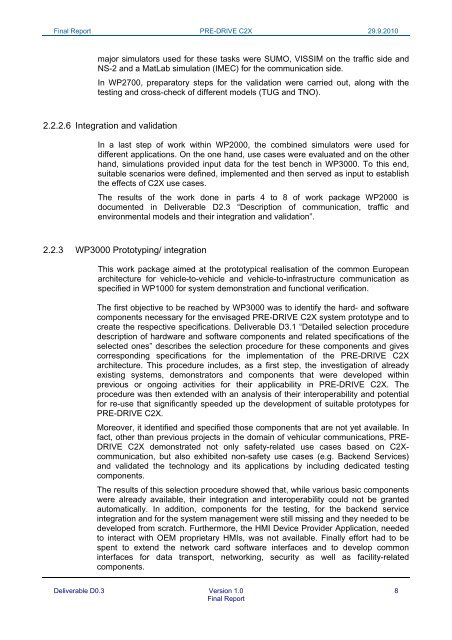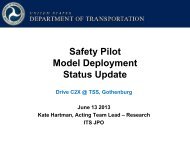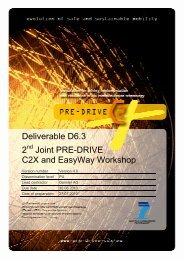PRE-DRIVE C2X Deliverable D0.3 Final report_20100929.pdf
PRE-DRIVE C2X Deliverable D0.3 Final report_20100929.pdf
PRE-DRIVE C2X Deliverable D0.3 Final report_20100929.pdf
You also want an ePaper? Increase the reach of your titles
YUMPU automatically turns print PDFs into web optimized ePapers that Google loves.
<strong>Final</strong> Report <strong>PRE</strong>-<strong>DRIVE</strong> <strong>C2X</strong> 29.9.2010<br />
major simulators used for these tasks were SUMO, VISSIM on the traffic side and<br />
NS-2 and a MatLab simulation (IMEC) for the communication side.<br />
In WP2700, preparatory steps for the validation were carried out, along with the<br />
testing and cross-check of different models (TUG and TNO).<br />
2.2.2.6 Integration and validation<br />
In a last step of work within WP2000, the combined simulators were used for<br />
different applications. On the one hand, use cases were evaluated and on the other<br />
hand, simulations provided input data for the test bench in WP3000. To this end,<br />
suitable scenarios were defined, implemented and then served as input to establish<br />
the effects of <strong>C2X</strong> use cases.<br />
The results of the work done in parts 4 to 8 of work package WP2000 is<br />
documented in <strong>Deliverable</strong> D2.3 “Description of communication, traffic and<br />
environmental models and their integration and validation”.<br />
2.2.3 WP3000 Prototyping/ integration<br />
This work package aimed at the prototypical realisation of the common European<br />
architecture for vehicle-to-vehicle and vehicle-to-infrastructure communication as<br />
specified in WP1000 for system demonstration and functional verification.<br />
The first objective to be reached by WP3000 was to identify the hard- and software<br />
components necessary for the envisaged <strong>PRE</strong>-<strong>DRIVE</strong> <strong>C2X</strong> system prototype and to<br />
create the respective specifications. <strong>Deliverable</strong> D3.1 “Detailed selection procedure<br />
description of hardware and software components and related specifications of the<br />
selected ones” describes the selection procedure for these components and gives<br />
corresponding specifications for the implementation of the <strong>PRE</strong>-<strong>DRIVE</strong> <strong>C2X</strong><br />
architecture. This procedure includes, as a first step, the investigation of already<br />
existing systems, demonstrators and components that were developed within<br />
previous or ongoing activities for their applicability in <strong>PRE</strong>-<strong>DRIVE</strong> <strong>C2X</strong>. The<br />
procedure was then extended with an analysis of their interoperability and potential<br />
for re-use that significantly speeded up the development of suitable prototypes for<br />
<strong>PRE</strong>-<strong>DRIVE</strong> <strong>C2X</strong>.<br />
Moreover, it identified and specified those components that are not yet available. In<br />
fact, other than previous projects in the domain of vehicular communications, <strong>PRE</strong>-<br />
<strong>DRIVE</strong> <strong>C2X</strong> demonstrated not only safety-related use cases based on <strong>C2X</strong>communication,<br />
but also exhibited non-safety use cases (e.g. Backend Services)<br />
and validated the technology and its applications by including dedicated testing<br />
components.<br />
The results of this selection procedure showed that, while various basic components<br />
were already available, their integration and interoperability could not be granted<br />
automatically. In addition, components for the testing, for the backend service<br />
integration and for the system management were still missing and they needed to be<br />
developed from scratch. Furthermore, the HMI Device Provider Application, needed<br />
to interact with OEM proprietary HMIs, was not available. <strong>Final</strong>ly effort had to be<br />
spent to extend the network card software interfaces and to develop common<br />
interfaces for data transport, networking, security as well as facility-related<br />
components.<br />
<strong>Deliverable</strong> <strong>D0.3</strong> Version 1.0 8<br />
<strong>Final</strong> Report







